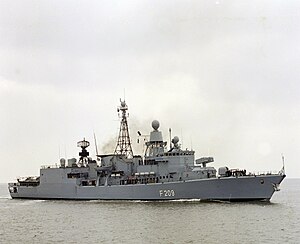
The German Navy is the navy of Germany and part of the unified Bundeswehr, the German Armed Forces. The German Navy was originally known as the Bundesmarine from 1956 to 1995, when Deutsche Marine became the official name with respect to the 1990 incorporation of the East German Volksmarine. It is deeply integrated into the NATO alliance. Its primary mission is protection of Germany's territorial waters and maritime infrastructure as well as sea lines of communication. Apart from this, the German Navy participates in peacekeeping operations, and renders humanitarian assistance and disaster relief. It also participates in anti-piracy operations.
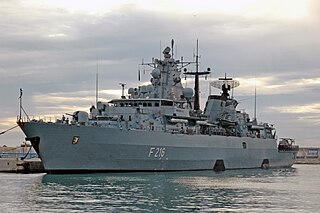
The F123 Brandenburg class is a class of German frigate. They were ordered by the German Navy in June 1989 and completed and commissioned between 1994 and 1996, replacing the Hamburg-class destroyers. The ships primarily carry out anti-submarine warfare (ASW), but they also contribute to local anti-aircraft defenses, the tactical command of squadrons, and surface-to-surface warfare operations. Together with the F124 Sachsen class frigates, they are the mainstay of the German surface fleet.

The eight F122 Bremen-class frigates of the German Navy was a series of frigates commissioned between 1982 and 1990. The design was based on the proven and robust Dutch Kortenaer class but used a different propulsion system and hangar lay-out. The ships were built for anti-submarine warfare as a primary task although they were not fitted with towed array sonars. They were also equipped for anti-surface warfare, while having anti-aircraft warfare point defences.

The F125 Baden-Württemberg-class frigates are a series of frigates of the German Navy, which were designed and constructed by ARGE F125, a joint-venture of Thyssen-Krupp and Lürssen. The Baden-Württemberg class is one the heaviest displacement of any class of frigates worldwide. They have replaced the Bremen class. They are primarily designed for low and medium intensity maritime stabilization operations, where they are supposed to provide sea-to-land tactical fire support, asymmetric threat control at sea and support of special forces.

Operation Atalanta, formally European Union Naval ForceSomalia, is an ongoing counter-piracy military operation at sea off the Horn of Africa and in the Western Indian Ocean, that is the first naval operation conducted by the European Union (EU), in support of United Nations resolutions 1814, 1816, 1838, and 1846 adopted in 2008 by the United Nations Security Council. The operational headquarters is currently located at the Spanish Operation Headquarters (ESOHQ) at Naval Station Rota in Spain, having moved from London as a result of the British withdrawal from the EU.
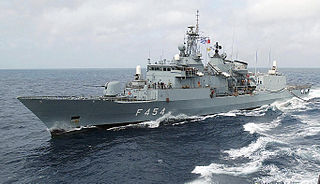
The Greek frigate Psara (F-454) is the third ship of the Greek Hydra-class frigates. It is based on the Blohm + Voss MEKO 200 frigate class and was built by Hellenic Shipyards Co. at Skaramangas as part of the programme. She has participated in various NATO and international operations such as Sharp Guard, Decisive Enhancement, Operation Enduring Freedom, EU Operation Atalanta.
MV Hansa Stavanger was a German container ship. The owner of the ship was Schiffahrts-Gesellschaft MS "HANSA STAVANGER" Co. KG. The Hansa Stavanger was built in 1997 at Guangzhou Wenchong Shipyard in the Chinese city of Guangzhou. Her loading capacity is 20,526 GT & she could transport 1,550 containers on board. She was captured by Somali pirates on 4 April 2009. Around 1 May 2009, USS Boxer and a screen of German Navy warships assisted approximately 200 members of the German special police unit GSG-9 in approaching the hijacked ship. During the last phase of the operation, James L. Jones, the U.S. President's National Security Advisor, withheld final approval for the operation out of concern for the safety of the 25 sailors aboard the vessel. This led the German Federal Ministry of Defence to abort the planned attack on the freighter and the GSG-9 unit returned to their base of operations at the airport of Mombasa, Kenya.

The action of 7 September 2009 took place when the German frigate Brandenburg, taking part of Operation Atalanta, chased and captured a pirate skiff south of Mukalla, in the Gulf of Aden, after suspicious activity was spotted on the small vessel by the frigate's helicopter during a reconnaissance mission. The boat was disabled by gunfire, and one suspect from her crew was killed. Four individuals were captured and weaponry confiscated and eventually destroyed.

Sachsen is a Sachsen-class frigate of the German Navy, the lead ship of her class.

Brandenburg is a Brandenburg-class frigate of the German Navy, and the lead ship of her class.
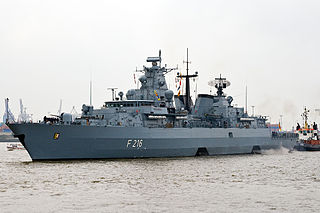
Schleswig-Holstein is a Brandenburg-class frigate of the German Navy.
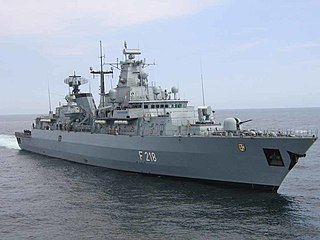
Mecklenburg-Vorpommern (F218) is a Brandenburg-class frigate of the German Navy.

Bremen was a Bremen-class frigate of the German Navy. She was the lead ship of the class, and the second surface warship to serve with one of the navies of Germany to be named after the city of Bremen, in the state of Bremen. Her predecessor was the cruiser SMS Bremen of the Imperial German Navy, one of the Bremen class cruiser.

Niedersachsen was a Bremen-class frigate of the German Navy. She was the second ship of the class, and the second surface warship to serve with one of the navies of Germany to be named after the state of Lower Saxony, German: Niedersachsen. Her predecessor was the minelayer Niedersachsen of the Kriegsmarine. The frigate entered service with the Bundesmarine in 1982, serving for 32 years until being decommissioned in 2015.

Emden was a Bremen-class frigate of the German Navy. She was the fourth ship of the class, and the fifth ship to serve with one of the navies of Germany to be named after the city of Emden, in Lower Saxony. Her predecessor was the frigate Emden of the Bundesmarine, one of the Köln class.

Köln was a Bremen-class frigate of the German Navy. She was the fifth ship of the class, and the fifth ship to serve with one of the navies of Germany to be named after the city of Cologne, in North Rhine-Westphalia. Her predecessor was the frigate Köln of the Bundesmarine, lead ship of the Köln class.

Karlsruhe was a Bremen-class frigate of the German Navy. She was the sixth ship of the class to enter service, and the fifth ship to serve with one of the navies of Germany to be named after the city of Karlsruhe, in Baden-Württemberg. She is currently laid up, pending disposal as a trials and target ship.

Augsburg is a Bremen-class frigate of the German Navy. The vessel was laid down in April 1987 by Bremer Vulkan, in Bremen, Germany and launched on 17 September 1987. The vessel was commissioned on 3 October 1989. The ship has been deployed as part of Operation Enduring Freedom – Horn of Africa and Operation Atalanta in the Middle East and Indian Ocean and has seen service in the Mediterranean Sea. The vessel is currently based at Wilhelmshaven, Germany.

Lübeck was a Bremen-class frigate of the German Navy.

The action of 3 March 2009 took place when the German Bremen-class frigateRheinland-Pfalz chased and captured a pirate skiff in the Gulf of Aden, after the persons on board the small vessel fired at and attempted to stop the German-owned tanker MV Courier. The operation marked the first time that the German Navy captured a hostile vessel at sea since World War II.
